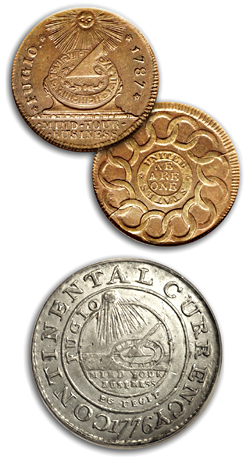300th Birthday Retrospective: The Coinage of Ben Franklin
|
"Making Cents"
The Signal
Saturday, January 21, 2006
| B |
Franklin was the youngest son of 17 children born to Josiah Franklin in Boston. He left for Philadelphia at age 12. His lengthy career in publishing, politics and many other areas has dubbed him the Renaissance Man of the 18th Century.
Our half dollars of 1948-1963 featured Franklin on the front. Our $100 bills for the past 75 years have featured Franklin's likeness. And our very first national postal stamp featured Franklin — who was the first postmaster of Philadelphia. His post office still operates a block from the site of his home in the historic center of town.
Less well known is his interest in coinage and money.
Just before the issuance of federal coinage in 1793, Franklin had designed the Fugio cent, which featured 13 interlocking links representing the united colonies, and the now-famous motto, "Mind Your Business." It does not mean "mind your own business" as that phrase is used today, but rather, "pay attention to your affairs." These copper cents circulated along with coins of Great Britain and Ireland well into, and past, the Revolution.
In 1729, Franklin wrote a treatise on the subject, "A Modest Enquiry into the Nature and Necessity of a Paper Currency." It was the first stab at establishing a national paper currency to offset the shortage of hard money (silver and gold coins) in the 18th Century in the colonies.
As a printer, Franklin printed paper money for the colony of New Jersey. He included the famous leaf imprint, which was, at the time, a deterrent to counterfeiting. These notes were issued from 1737 to the 1780s.
Starting in 1776 and with the Revolution, Franklin designed and printed various forms of paper currency authorized by the Continental Congress for the colonies. The famous and very rare Continental dollar coin features his design of 13 links. It likely was a pattern issue, as very few were made or used.
Because Continental currency notes were often discounted in exchange for silver or gold coins, and eventually by the 1780s considered nearly worthless, the phrase "not worth a Continental" arose. Today, these little notes — often in odd denominations such as 6-1/4 cents — are quite valuable, since most were destroyed after Independence, and many that survived have since deteriorated.
Franklin's legacy goes far beyond his numismatic contributions, but they can and do fill several volumes. All Americans should read at least one biography of the man and his extraordinary life. Certainly our history books can devote more than a few pages to his service to the country and the world.
Dr. Sol Taylor of Sherman Oaks is president of the Society of Lincoln Cent Collectors and author of The Standard Guide to the Lincoln Cent. Click here for ordering information.
©2006, THE SIGNAL · ALL RIGHTS RESERVED.
